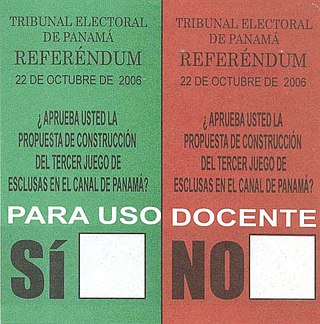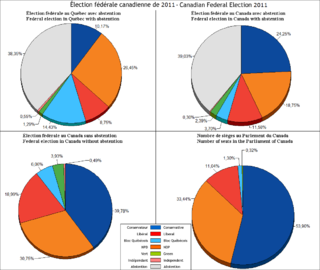Plurality voting refers to electoral systems in the candidates in an electoral district who poll more than any other are elected. Used for elections of various offices or representative bodies, it is often contrasted with proportional representation. Plurality voting is also called simple majority or relative majority voting, however, is it also often explicitly distinguished from majority voting, in which a winning candidate must receive an absolute majority of votes: more than half of all votes.

The two-round system (TRS), also known as runoff voting, second ballot, or ballotage, is a voting method used to elect a single candidate. The first round is held using simple plurality to choose the top-two candidates, and then in the second round the winner is chosen by majority vote. The two-round system is widely used in the election of legislative bodies and directly elected presidents.

Voting is a method by which a group, such as a meeting or an electorate, convenes together for the purpose of making a collective decision or expressing an opinion usually following discussions, debates or election campaigns. Democracies elect holders of high office by voting. Residents of a jurisdiction represented by an elected official are called "constituents", and the constituents who choose to cast a ballot for their chosen candidate are called "voters." There are different systems for collecting votes, but while many of the systems used in decision-making can also be used as electoral systems, any which cater to proportional representation can only be used in elections.
Coombs' method or the Coombs rule is a ranked voting system which uses a ballot counting method for ranked voting created by Clyde Coombs. Coombs' method can be thought of as a cross between instant-runoff voting and anti-plurality voting.
Block voting, also known as bloc voting, refers to certain electoral systems where multiple candidates are elected simultaneously. They do not guarantee minority representation and allow a group of voters to ensure that only their preferred candidates are elected. In these systems, a voter can select as many candidates as there are open seats. That is, the voter has as many votes to cast as the number of seats to fill. The block voting systems are among various election systems available for use in multi-member districts where the voting system allows for the selection of multiple winners at once.

A plurality vote or relative majority describes the circumstance when a party, candidate, or proposition polls more votes than any other but does not receive more than half of all votes cast.

The Council of States is the upper house of the Federal Assembly, and the lower house being the National Council. It comprises 46 members.
A supermajority is a requirement for a proposal to gain a specified level of support which is greater than the threshold of more than one-half used for a simple majority. Supermajority rules in a democracy can help to prevent a majority from eroding fundamental rights of a minority, but they can also hamper efforts to respond to problems and encourage corrupt compromises at times when action is taken. Changes to constitutions, especially those with entrenched clauses, commonly require supermajority support in a legislature. Parliamentary procedure requires that any action of a deliberative assembly that may alter the rights of a minority have a supermajority requirement, such as a two-thirds vote. In consensus democracy the supermajority rule is applied in most cases.
The Federal Convention, also known as the Federal Assembly, is, together with the Joint Committee, one of two non-standing constitutional bodies in the federal institutional system of the Federal Republic of Germany. It is convened solely for the purpose of electing the President of Germany, either every five years or within 30 days of the premature termination of a presidential term. The Federal Convention consists of all members of the German federal parliament (Bundestag) and the same number of delegates from the 16 federated states. Those delegates are elected by the state parliaments for this purpose only.
Majority rule is the principle that a group which has more than half of all voters should be allowed to make the decisions for a group. Majority rule is the binary decision rule most often used in decision-making bodies, including many legislatures of democratic nations. Where no one party wins a majority of the seats in a legislature, the majority of legislators that wields power is partly composed of members of other parties in support.
At a national level, Greece holds elections for its legislature, the Hellenic Parliament.

Abstention is a term in election procedure for when a participant in a vote either does not go to vote or, in parliamentary procedure, is present during the vote but does not cast a ballot. Abstention must be contrasted with "blank vote", in which a voter casts a ballot willfully made invalid by marking it wrongly or by not marking anything at all. A "blank voter" has voted, although their vote may be considered a spoilt vote, depending on each legislation, while an abstaining voter has not voted. Both forms may or may not, depending on the circumstances, be considered to be a protest vote. Abstention is related to political apathy and low voter turnout.
The majority criterion is a voting system criterion. The criterion states that "if only one candidate is ranked first by a majority of voters, then that candidate must win."
In electoral systems, a wasted vote is any vote that does not receive representation in the final election outcome.
The exhaustive ballot is a voting system used to elect a single winner. Under the exhaustive ballot the elector casts a single vote for their chosen candidate. However, if no candidate is supported by an overall majority of votes then the candidate with the fewest votes is eliminated and a further round of voting occurs. This process is repeated for as many rounds as necessary until one candidate has a majority.
Deliberative assemblies – bodies that use parliamentary procedure to arrive at decisions – use several methods of voting on motions. The regular methods of voting in such bodies are a voice vote, a rising vote, and a show of hands. Additional forms of voting include a recorded vote and balloting.
The multiple non-transferable vote (MNTV) is a group of voting system, in which voters elect several representatives at once, with each voter having more than one vote. MNTV uses multi-member electoral districts or only one district, which contains all voters, which is used to provide at-large representation.
Plurality block voting, also known as plurality-at-large voting, bloc vote or block voting (BV) is a non-proportional voting system for electing representatives in multi-winner elections. Each voter may cast as many votes as the number of seats to be filled. The usual result when the candidates divide into parties is that the most popular party in the district sees its full slate of candidates elected in a seemingly landslide victory.
Instant-runoff voting (IRV), also known as plurality with elimination or plurality loser, is a ranked-choice voting system that modifies plurality by repeatedly eliminating the last-place finisher until only one candidate is left. In the United Kingdom, it is generally called the alternative vote (AV). In the United States, IRV is often conflated with ranked-choice voting (RCV); however, this conflation is not completely standard, and social choice theorists tend to prefer more explicit terms.
The electoral system of Hungary is the set of voting methods and rules used in Hungary, including mainly the system for electing members of the National Assembly : and local government elections. The Hungarian electoral system also includes the systems used for the European Parliament elections held in Hungary and the elections of minority local government elections, as well as the rules of referendums and similar initiatives. The president of the republic is not directly elected.




